Dreamworld Tragedy: Analysis of Negligence Claims and Duty of Care
VerifiedAdded on 2021/01/05
|8
|1549
|46
Report
AI Summary
This report provides a detailed analysis of the Dreamworld tragedy, examining the negligence claims against the theme park and its responsible parties. It explores the concept of duty of care, highlighting breaches by the operational manager of health and safety and the auditor, which led to fatalities, psychiatric injuries, and financial losses. The report discusses the perspectives of both the plaintiffs, including the deceased visitors' estates, injured individuals, and those with financial losses, and the defendants, focusing on the argument that the incident was an accident. It references relevant legal cases like Imbree v McNeilly and Carrier v Bonham to support the claims of negligence and the extent of damages. Furthermore, the report considers the assumptions made, such as the impact on Ardent Leisure Group and its employees, and identifies the key issue as the breach of duty of care. It also proposes legal solutions like compensatory damages and restitution to address the losses suffered by both parties. The report emphasizes the need for improved safety measures and accountability to prevent similar incidents in the future.
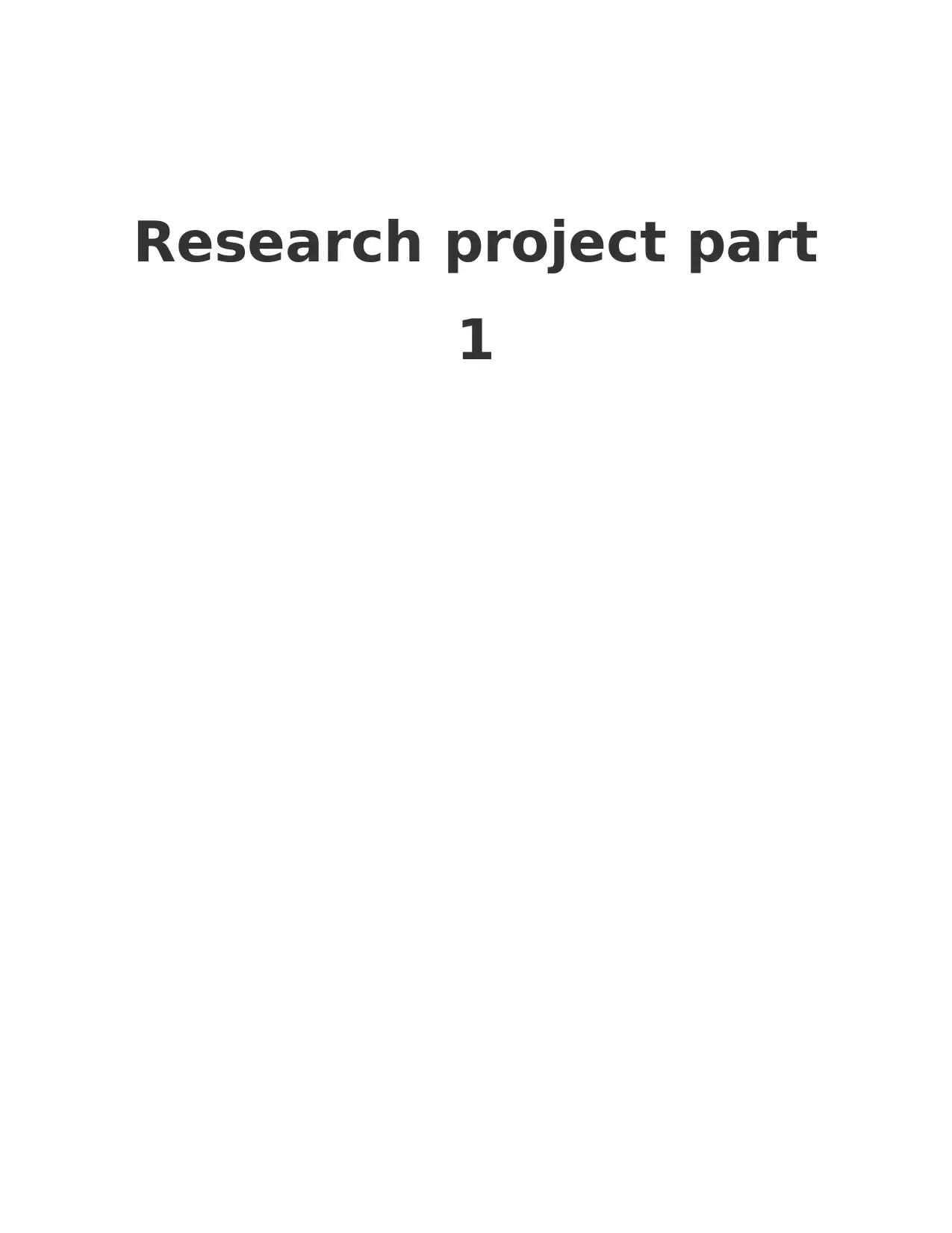
Research project part
1
1
Paraphrase This Document
Need a fresh take? Get an instant paraphrase of this document with our AI Paraphraser
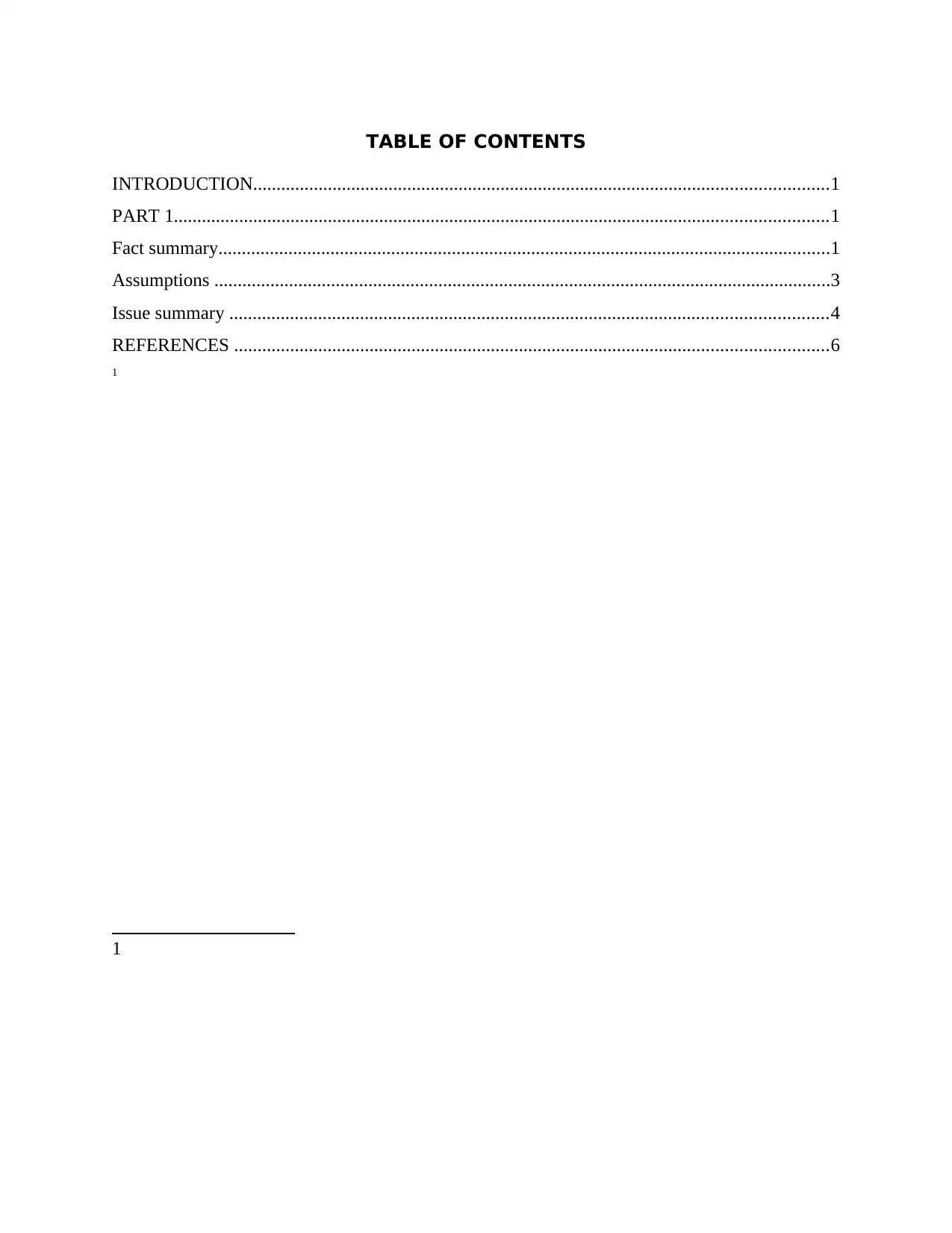
TABLE OF CONTENTS
INTRODUCTION...........................................................................................................................1
PART 1............................................................................................................................................1
Fact summary...................................................................................................................................1
Assumptions ....................................................................................................................................3
Issue summary ................................................................................................................................4
REFERENCES ...............................................................................................................................6
1
1
INTRODUCTION...........................................................................................................................1
PART 1............................................................................................................................................1
Fact summary...................................................................................................................................1
Assumptions ....................................................................................................................................3
Issue summary ................................................................................................................................4
REFERENCES ...............................................................................................................................6
1
1
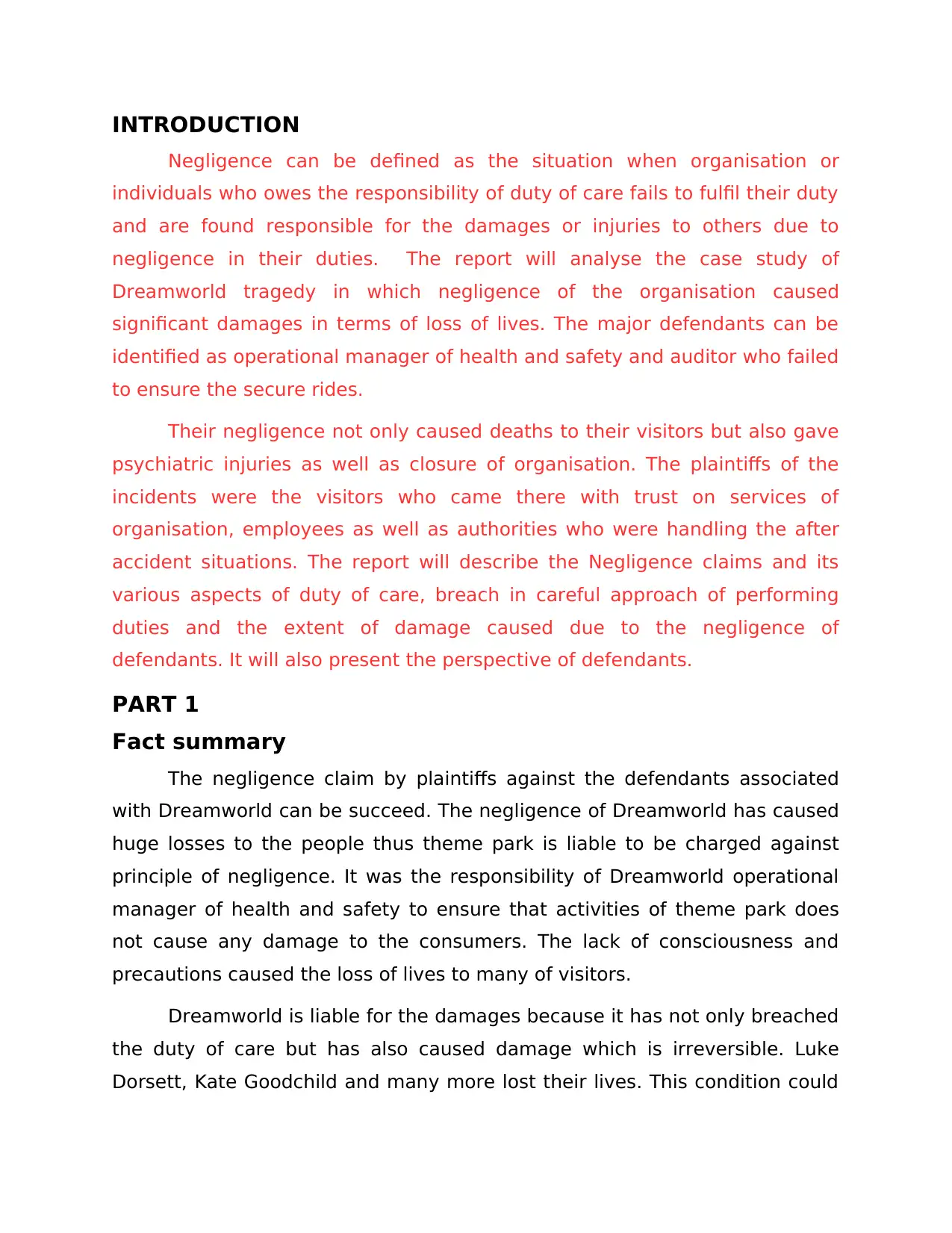
INTRODUCTION
Negligence can be defined as the situation when organisation or
individuals who owes the responsibility of duty of care fails to fulfil their duty
and are found responsible for the damages or injuries to others due to
negligence in their duties. The report will analyse the case study of
Dreamworld tragedy in which negligence of the organisation caused
significant damages in terms of loss of lives. The major defendants can be
identified as operational manager of health and safety and auditor who failed
to ensure the secure rides.
Their negligence not only caused deaths to their visitors but also gave
psychiatric injuries as well as closure of organisation. The plaintiffs of the
incidents were the visitors who came there with trust on services of
organisation, employees as well as authorities who were handling the after
accident situations. The report will describe the Negligence claims and its
various aspects of duty of care, breach in careful approach of performing
duties and the extent of damage caused due to the negligence of
defendants. It will also present the perspective of defendants.
PART 1
Fact summary
The negligence claim by plaintiffs against the defendants associated
with Dreamworld can be succeed. The negligence of Dreamworld has caused
huge losses to the people thus theme park is liable to be charged against
principle of negligence. It was the responsibility of Dreamworld operational
manager of health and safety to ensure that activities of theme park does
not cause any damage to the consumers. The lack of consciousness and
precautions caused the loss of lives to many of visitors.
Dreamworld is liable for the damages because it has not only breached
the duty of care but has also caused damage which is irreversible. Luke
Dorsett, Kate Goodchild and many more lost their lives. This condition could
Negligence can be defined as the situation when organisation or
individuals who owes the responsibility of duty of care fails to fulfil their duty
and are found responsible for the damages or injuries to others due to
negligence in their duties. The report will analyse the case study of
Dreamworld tragedy in which negligence of the organisation caused
significant damages in terms of loss of lives. The major defendants can be
identified as operational manager of health and safety and auditor who failed
to ensure the secure rides.
Their negligence not only caused deaths to their visitors but also gave
psychiatric injuries as well as closure of organisation. The plaintiffs of the
incidents were the visitors who came there with trust on services of
organisation, employees as well as authorities who were handling the after
accident situations. The report will describe the Negligence claims and its
various aspects of duty of care, breach in careful approach of performing
duties and the extent of damage caused due to the negligence of
defendants. It will also present the perspective of defendants.
PART 1
Fact summary
The negligence claim by plaintiffs against the defendants associated
with Dreamworld can be succeed. The negligence of Dreamworld has caused
huge losses to the people thus theme park is liable to be charged against
principle of negligence. It was the responsibility of Dreamworld operational
manager of health and safety to ensure that activities of theme park does
not cause any damage to the consumers. The lack of consciousness and
precautions caused the loss of lives to many of visitors.
Dreamworld is liable for the damages because it has not only breached
the duty of care but has also caused damage which is irreversible. Luke
Dorsett, Kate Goodchild and many more lost their lives. This condition could
⊘ This is a preview!⊘
Do you want full access?
Subscribe today to unlock all pages.

Trusted by 1+ million students worldwide
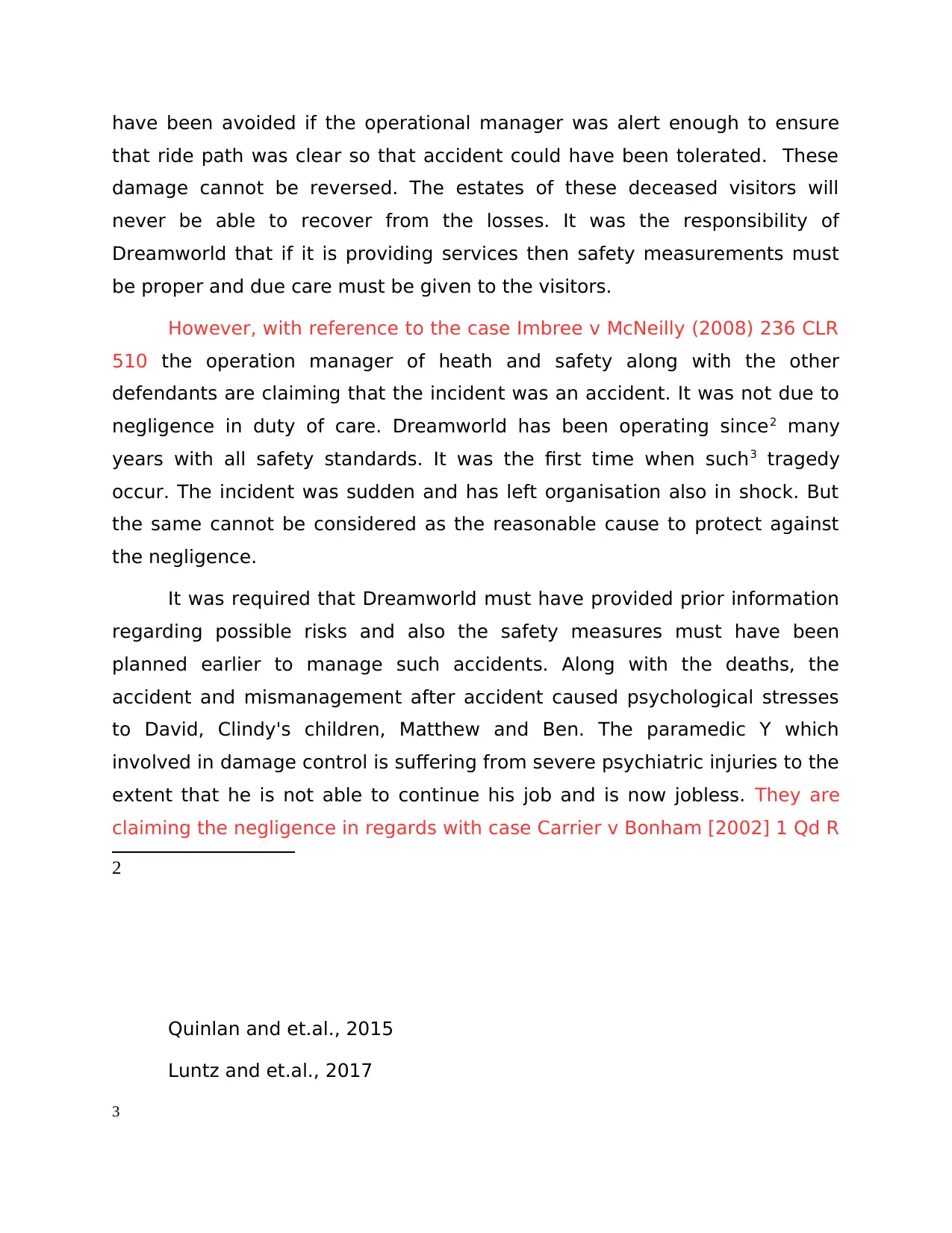
have been avoided if the operational manager was alert enough to ensure
that ride path was clear so that accident could have been tolerated. These
damage cannot be reversed. The estates of these deceased visitors will
never be able to recover from the losses. It was the responsibility of
Dreamworld that if it is providing services then safety measurements must
be proper and due care must be given to the visitors.
However, with reference to the case Imbree v McNeilly (2008) 236 CLR
510 the operation manager of heath and safety along with the other
defendants are claiming that the incident was an accident. It was not due to
negligence in duty of care. Dreamworld has been operating since2 many
years with all safety standards. It was the first time when such3 tragedy
occur. The incident was sudden and has left organisation also in shock. But
the same cannot be considered as the reasonable cause to protect against
the negligence.
It was required that Dreamworld must have provided prior information
regarding possible risks and also the safety measures must have been
planned earlier to manage such accidents. Along with the deaths, the
accident and mismanagement after accident caused psychological stresses
to David, Clindy's children, Matthew and Ben. The paramedic Y which
involved in damage control is suffering from severe psychiatric injuries to the
extent that he is not able to continue his job and is now jobless. They are
claiming the negligence in regards with case Carrier v Bonham [2002] 1 Qd R
2
Quinlan and et.al., 2015
Luntz and et.al., 2017
3
that ride path was clear so that accident could have been tolerated. These
damage cannot be reversed. The estates of these deceased visitors will
never be able to recover from the losses. It was the responsibility of
Dreamworld that if it is providing services then safety measurements must
be proper and due care must be given to the visitors.
However, with reference to the case Imbree v McNeilly (2008) 236 CLR
510 the operation manager of heath and safety along with the other
defendants are claiming that the incident was an accident. It was not due to
negligence in duty of care. Dreamworld has been operating since2 many
years with all safety standards. It was the first time when such3 tragedy
occur. The incident was sudden and has left organisation also in shock. But
the same cannot be considered as the reasonable cause to protect against
the negligence.
It was required that Dreamworld must have provided prior information
regarding possible risks and also the safety measures must have been
planned earlier to manage such accidents. Along with the deaths, the
accident and mismanagement after accident caused psychological stresses
to David, Clindy's children, Matthew and Ben. The paramedic Y which
involved in damage control is suffering from severe psychiatric injuries to the
extent that he is not able to continue his job and is now jobless. They are
claiming the negligence in regards with case Carrier v Bonham [2002] 1 Qd R
2
Quinlan and et.al., 2015
Luntz and et.al., 2017
3
Paraphrase This Document
Need a fresh take? Get an instant paraphrase of this document with our AI Paraphraser
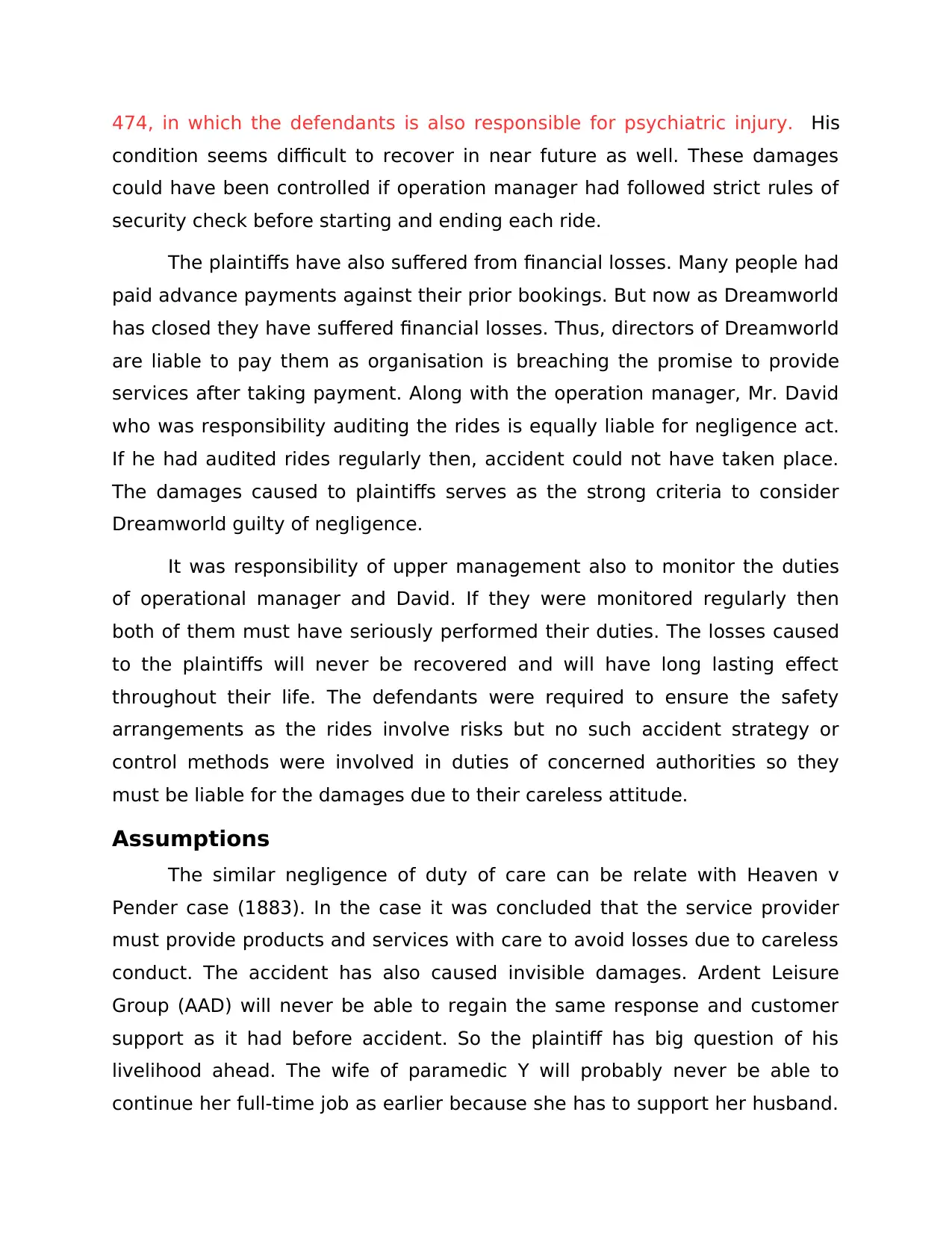
474, in which the defendants is also responsible for psychiatric injury. His
condition seems difficult to recover in near future as well. These damages
could have been controlled if operation manager had followed strict rules of
security check before starting and ending each ride.
The plaintiffs have also suffered from financial losses. Many people had
paid advance payments against their prior bookings. But now as Dreamworld
has closed they have suffered financial losses. Thus, directors of Dreamworld
are liable to pay them as organisation is breaching the promise to provide
services after taking payment. Along with the operation manager, Mr. David
who was responsibility auditing the rides is equally liable for negligence act.
If he had audited rides regularly then, accident could not have taken place.
The damages caused to plaintiffs serves as the strong criteria to consider
Dreamworld guilty of negligence.
It was responsibility of upper management also to monitor the duties
of operational manager and David. If they were monitored regularly then
both of them must have seriously performed their duties. The losses caused
to the plaintiffs will never be recovered and will have long lasting effect
throughout their life. The defendants were required to ensure the safety
arrangements as the rides involve risks but no such accident strategy or
control methods were involved in duties of concerned authorities so they
must be liable for the damages due to their careless attitude.
Assumptions
The similar negligence of duty of care can be relate with Heaven v
Pender case (1883). In the case it was concluded that the service provider
must provide products and services with care to avoid losses due to careless
conduct. The accident has also caused invisible damages. Ardent Leisure
Group (AAD) will never be able to regain the same response and customer
support as it had before accident. So the plaintiff has big question of his
livelihood ahead. The wife of paramedic Y will probably never be able to
continue her full-time job as earlier because she has to support her husband.
condition seems difficult to recover in near future as well. These damages
could have been controlled if operation manager had followed strict rules of
security check before starting and ending each ride.
The plaintiffs have also suffered from financial losses. Many people had
paid advance payments against their prior bookings. But now as Dreamworld
has closed they have suffered financial losses. Thus, directors of Dreamworld
are liable to pay them as organisation is breaching the promise to provide
services after taking payment. Along with the operation manager, Mr. David
who was responsibility auditing the rides is equally liable for negligence act.
If he had audited rides regularly then, accident could not have taken place.
The damages caused to plaintiffs serves as the strong criteria to consider
Dreamworld guilty of negligence.
It was responsibility of upper management also to monitor the duties
of operational manager and David. If they were monitored regularly then
both of them must have seriously performed their duties. The losses caused
to the plaintiffs will never be recovered and will have long lasting effect
throughout their life. The defendants were required to ensure the safety
arrangements as the rides involve risks but no such accident strategy or
control methods were involved in duties of concerned authorities so they
must be liable for the damages due to their careless attitude.
Assumptions
The similar negligence of duty of care can be relate with Heaven v
Pender case (1883). In the case it was concluded that the service provider
must provide products and services with care to avoid losses due to careless
conduct. The accident has also caused invisible damages. Ardent Leisure
Group (AAD) will never be able to regain the same response and customer
support as it had before accident. So the plaintiff has big question of his
livelihood ahead. The wife of paramedic Y will probably never be able to
continue her full-time job as earlier because she has to support her husband.
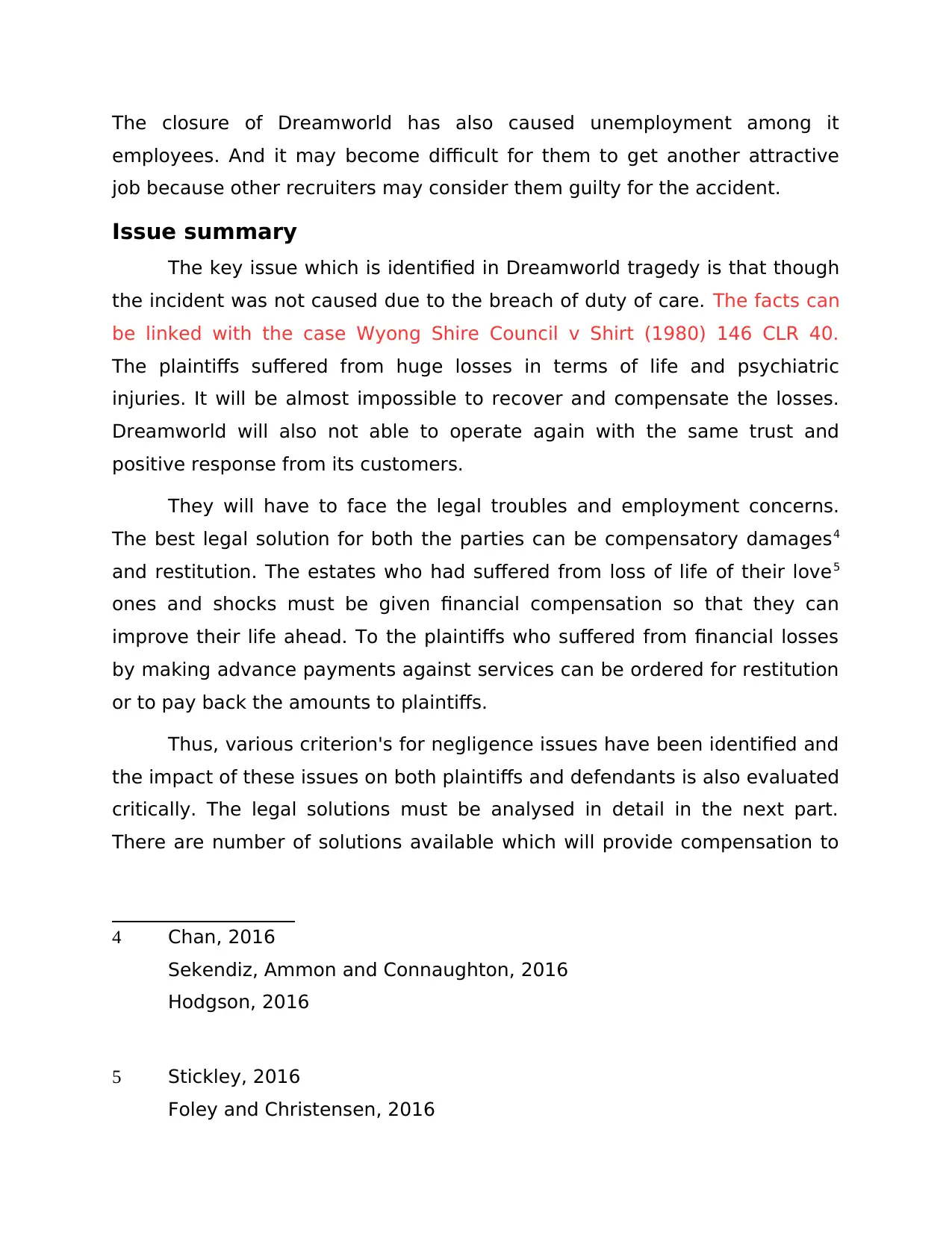
The closure of Dreamworld has also caused unemployment among it
employees. And it may become difficult for them to get another attractive
job because other recruiters may consider them guilty for the accident.
Issue summary
The key issue which is identified in Dreamworld tragedy is that though
the incident was not caused due to the breach of duty of care. The facts can
be linked with the case Wyong Shire Council v Shirt (1980) 146 CLR 40.
The plaintiffs suffered from huge losses in terms of life and psychiatric
injuries. It will be almost impossible to recover and compensate the losses.
Dreamworld will also not able to operate again with the same trust and
positive response from its customers.
They will have to face the legal troubles and employment concerns.
The best legal solution for both the parties can be compensatory damages4
and restitution. The estates who had suffered from loss of life of their love5
ones and shocks must be given financial compensation so that they can
improve their life ahead. To the plaintiffs who suffered from financial losses
by making advance payments against services can be ordered for restitution
or to pay back the amounts to plaintiffs.
Thus, various criterion's for negligence issues have been identified and
the impact of these issues on both plaintiffs and defendants is also evaluated
critically. The legal solutions must be analysed in detail in the next part.
There are number of solutions available which will provide compensation to
4 Chan, 2016
Sekendiz, Ammon and Connaughton, 2016
Hodgson, 2016
5 Stickley, 2016
Foley and Christensen, 2016
employees. And it may become difficult for them to get another attractive
job because other recruiters may consider them guilty for the accident.
Issue summary
The key issue which is identified in Dreamworld tragedy is that though
the incident was not caused due to the breach of duty of care. The facts can
be linked with the case Wyong Shire Council v Shirt (1980) 146 CLR 40.
The plaintiffs suffered from huge losses in terms of life and psychiatric
injuries. It will be almost impossible to recover and compensate the losses.
Dreamworld will also not able to operate again with the same trust and
positive response from its customers.
They will have to face the legal troubles and employment concerns.
The best legal solution for both the parties can be compensatory damages4
and restitution. The estates who had suffered from loss of life of their love5
ones and shocks must be given financial compensation so that they can
improve their life ahead. To the plaintiffs who suffered from financial losses
by making advance payments against services can be ordered for restitution
or to pay back the amounts to plaintiffs.
Thus, various criterion's for negligence issues have been identified and
the impact of these issues on both plaintiffs and defendants is also evaluated
critically. The legal solutions must be analysed in detail in the next part.
There are number of solutions available which will provide compensation to
4 Chan, 2016
Sekendiz, Ammon and Connaughton, 2016
Hodgson, 2016
5 Stickley, 2016
Foley and Christensen, 2016
⊘ This is a preview!⊘
Do you want full access?
Subscribe today to unlock all pages.

Trusted by 1+ million students worldwide

plaintiffs and will allow defendants to correct and improve the adverse
situation which has been caused due to their negligence conduct.
situation which has been caused due to their negligence conduct.
Paraphrase This Document
Need a fresh take? Get an instant paraphrase of this document with our AI Paraphraser

REFERENCES
Books and Journals
Chan, G.K.Y., 2016. Finding common law duty of care from statutory duties:
All within the Anns framework. Tort Law Review. 24(1). p.14.
Foley, M. and Christensen, M., 2016. Negligence and the Duty of Care: A
Case Study Discussion. Singapore Nursing Journal. 43(1).
Hodgson, D., 2016. The law of intervening causation. Routledge.
Luntz, H., Hambly, D., and et.al., 2017. Torts: cases and commentary.
LexisNexis Butterworths.
Quinlan, M., Fitzpatrick, S.J., and et.al., 2015. Administering the cost of
death: Organisational perspectives on workers' compensation and
common law claims following traumatic death at work in Australia.
International journal of law and psychiatry. 38. pp.8-17.
Sekendiz, B., Ammon, R. and Connaughton, D.P., 2016. An Examination of
Waiver Usage and Injury-Related Liability Claims in Health/Fitness
Facilities in Australia. JourQuinlan and et.al., 2015nal of Legal Aspects
of Sport. 26(2). pp.144-161.
Stickley, A.P., 2016. Australian torts law. LexisNexis Butterworths.
Books and Journals
Chan, G.K.Y., 2016. Finding common law duty of care from statutory duties:
All within the Anns framework. Tort Law Review. 24(1). p.14.
Foley, M. and Christensen, M., 2016. Negligence and the Duty of Care: A
Case Study Discussion. Singapore Nursing Journal. 43(1).
Hodgson, D., 2016. The law of intervening causation. Routledge.
Luntz, H., Hambly, D., and et.al., 2017. Torts: cases and commentary.
LexisNexis Butterworths.
Quinlan, M., Fitzpatrick, S.J., and et.al., 2015. Administering the cost of
death: Organisational perspectives on workers' compensation and
common law claims following traumatic death at work in Australia.
International journal of law and psychiatry. 38. pp.8-17.
Sekendiz, B., Ammon, R. and Connaughton, D.P., 2016. An Examination of
Waiver Usage and Injury-Related Liability Claims in Health/Fitness
Facilities in Australia. JourQuinlan and et.al., 2015nal of Legal Aspects
of Sport. 26(2). pp.144-161.
Stickley, A.P., 2016. Australian torts law. LexisNexis Butterworths.
1 out of 8
Related Documents
Your All-in-One AI-Powered Toolkit for Academic Success.
+13062052269
info@desklib.com
Available 24*7 on WhatsApp / Email
![[object Object]](/_next/static/media/star-bottom.7253800d.svg)
Unlock your academic potential
Copyright © 2020–2025 A2Z Services. All Rights Reserved. Developed and managed by ZUCOL.





